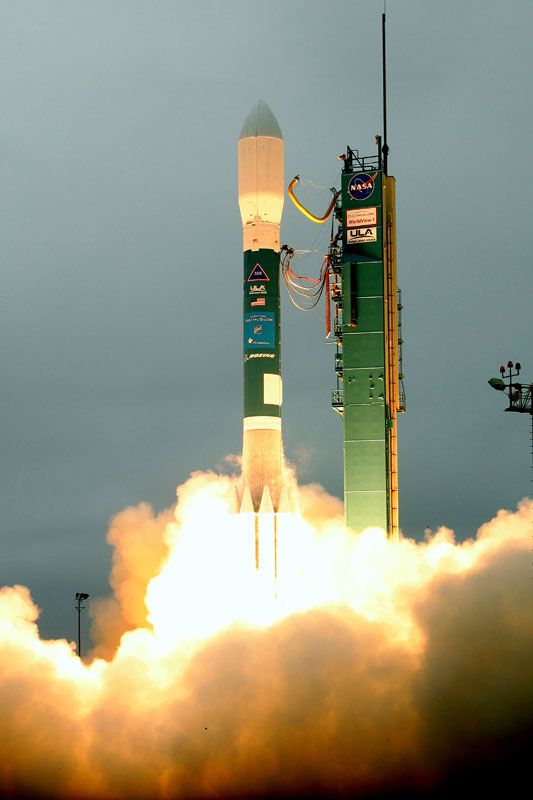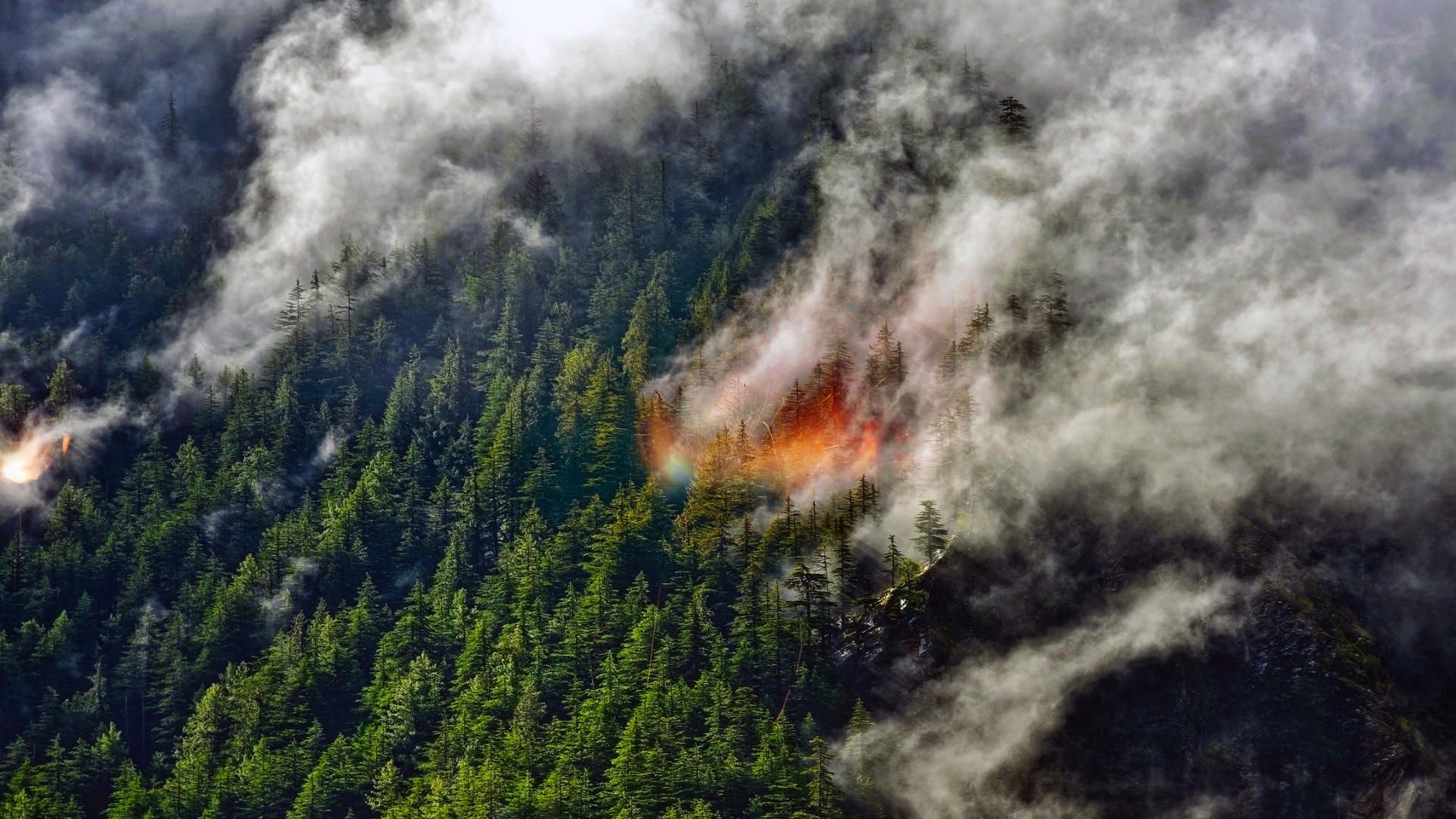Earth-Watching Satellite's Launch Success Sets Rocket Record

A sophisticated newEarth-imaging satellite with sharp eyes, nimble moves and a broad memory waslaunched Tuesday, riding the ever-dependable Delta 2 rocket into orbit during aflawless ascent that set a new reliability mark for modern space boosters.
Theuneventful countdown was punctuated by an on-time liftoff at 11:35 a.m. localtime (2:35 p.m. EDT; 1835 GMT) from Vandenberg Air Force Base, California. The12-story rocket racedoff the launch pad, roaring up through a deck of low clouds as it began toarc southward with the WorldView 1 satellite tucked neatly in its nose cone.
It took 73 minutes for thetwo-stage launcher to accomplish the job of hoisting the two-and-a-half-tonsatellite to the proper orbit, then safely deploying WorldView 1 for itsmission to survey the globe with advanced imaging capabilities.
Cheers and applause burstout in the control rooms when the successful launch was confirmed, and the joyseemed a little sweeter this time because a milestone for the rocket businesshad just been achieved.
It was the 75th consecutivesuccessful ascent for the Delta 2 rocket. No other single rocket design in thecurrent era has strung together such a long and spotless track record.
Delta 2 has been perfectsince May 1997, amassing its consecutive string by launching spacecraft formilitary, NASA and commercial users, including the Global Positioning Systemsatellites, the twin Marsrovers Spirit and Opportunity, the Spitzer Space Telescope and theMercury-bound MESSENGER orbiter. In the rocket's 130 flights overall sincedebuting in 1989, 128 of those launches have been successful.
"I love the Delta 2.We've been able to meet schedule, we've been able to put some exciting,exciting payloads out into orbit. I think one of the things that'srevolutionized the world is the GPS system. We were the ones that put all ofthose satellites up into orbit," said Kris Walsh, United Launch Alliance'sdirector of NASA and commercial programs for the Delta rocket.
Breaking space news, the latest updates on rocket launches, skywatching events and more!
"So I think it's beena tremendous boon for the United States government and commercial (customers).It's a great little rocket. I'll continue to fly it as long as I can."
The Delta 2's future
There are 25 Delta 2rockets remaining to fly over the next few years. "It's a pretty firmnumber, if we don't end up starting production again," Walsh said.
Thefuture launches include 11 flights for NASA counting next week's Dawnasteroid probe, the five remaining GPS 2R satellites for the Air Force, threecommercial missions and six rockets not yet sold, Walsh said.
Keeping the Delta 2 aroundfor the long-term depends on finding a government partner. The Pentagon andNASA have shared the costs over the past years. But the military will soon end its use ofthe Delta 2 in favor of the Evolved Expendable Launch Vehicles.
The Air Force has backedthe Delta 2 since the rocket's earliest days for launching the GPSconstellation. But after the five remaining satellites in the current seriesare launched soon, the Air Force will be turning its attention tonext-generation spacecraft that will fly on the larger Atlas 5 and Delta 4boosters.
That will leave NASA as themain government user of Delta 2. Thus far, the space agency has been reluctantto fund future production of the rocket and the associated infrastructuremaintenance entirely on its own.
"We'll continue (Delta2) as long as it's a viable rocket and we have a government anchorcustomer," Walsh said.
The new sharp-eyed orbiter
Benefiting from therocket's consecutive success No. 75 was the WorldView 1 spacecraft. Circling300 miles (482 kilometers) above the planet in polar orbit, ringing aroundEarth once every 95 minutes, the commercial Earth-imaging satellite will offera clarity not possible by any civilian satellite in orbit today.
Despite the lofty perch inspace, the satellite's remarkable vision can see objects on the ground as smallas 20 inches (50 centimeters) across. And its advanced picture-taking sensorpackage can produce such images with half-meter resolution covering 290,000square miles (751,100 sq. kilometers) of the planet's surface per day.
The anticipated quality hasthe U.S. government signed up as a customer to receive WorldView's images ofspecific global hot spots and areas of interest for intelligence-gathering. Andthe growing potential of commercial applications for such imagery ranges fromurban planners, real estate developers, environmental monitors and users of thewildly popular Google Earth.
DigitalGlobe,based in Longmont, Colorado, has operated its QuickBird satellite for nearlysix years. But the imminent addition of WorldView 1 promises to generate fivetimes the image-collecting capacity.
"Being able to satisfymany more customer orders and larger area collections is really the bigdifferentiator from QuickBird and our new satellite WorldView," said ChuckHerring, DigitalGlobe's director of corporate communications.
The two spacecraft workingin tandem will allow imaging a specific spot on Earth each day, cutting thecurrent three-to-five-day "revisit" rate of the solo QuickBird.
WorldView 1 also boasts amuch greater agility than its predecessor. Orientation-controlling gyroscopes,called control moment gyros, are flying on the Ball Aerospace-built craft,marking the first time such devices have been used by a commercial imagingsatellite, Herring said.
The gyros will enable thespacecraft to point itself about 10 times faster than QuickBird. That shouldincrease the satellite's picture-shooting time because imaging cannot beginuntil after the craft completes its turns and takes aim.
"The biggest thing isour ability to collect a lot more imagery," Herring said.
DigitalGlobe officials areanticipating being able to show off initial imagery from WorldView 1 in about amonth, just in time to coincide with the sixth anniversary of QuickBird'slaunch on a Delta 2 rocket from Vandenberg.
If all goes well, WorldView1 should be fully operational by year's end.
The growing market forEarth-imaging
Until WorldView entersservice, QuickBird remains the highest resolution commercial satellite of itstype. But WorldView 1 will be slightly better, offering 0.5-meter (1.6-foot)meter clarity versus 0.6-meter (about two-foot).
"For the casualuser...you wouldn't see a huge difference in the imagery. (To) an imageryanalyst, there is a difference in the resolution," Herring said.
A key constituent ofWorldView's products will be the National Geospatial-Intelligence Agency. Thegovernment awarded a contract to DigitalGlobe four years ago in excess of $500million to help launch the next-generation satellite.
"Theyhave areas on the ground they like us to image. We image them and send over theimagery," Herring said. "It is not as though all of the imagery thatwe take goes to them. They have the ability to request areas that we willimage...They're also able to purchase from the library as well."
The demand for data fromthe relatively young commercial Earth-imaging business is soaring, officialssay, as customers learn new ways to use the information.
"What we're reallyseeing is because of the availability...the applications are growingexponentially," Herring said.
State and local governmentsuse the imagery to keep tabs on urban growth, real estate developers can assessbuilding plans, insurance companies map out areas threatened by a high wildfirerisk and scientists can study environmental changes.
"At the beginning ofour operations, people would call and they wanted to track animals - herd ofelephants - because of the resolution they could see elephants. What we arefinding is it's less about understanding the individual animals and more aboutunderstanding the environment in which they live and mapping it out, doingchange detection," Herring said.
"It's mapping theecosystem, then keeping an up-to-date view of that ecosystem, understanding thehuman and environmental impacts that are occurring in those ecosystems, if theyput in a new walking path, there's deforesting going on or drought, how does itimpact the ecosystem."
DigitalGlobe's QuickBird isexpected to operate for another two years, and the new WorldView 1 has a lifeexpectancy of about seven-and-a-half-years. Builder of those two satellites,Ball Aerospace, is constructing the WorldView 2 craft for launch perhaps by theend of 2008. It could fly aboard one of the remaining yet-unsold Delta 2rockets.
Continuing to grow thecommercial imagery market will require more satellites, enabling the companiesto keep their picture supply as fresh as possible and expand the regionscovered with high-resolution photos.
"The industry needs toget more satellites up to address people's wish to not only update on a regularbasis but paint the globe," Herring said.
"From a global mappingstandpoint, we haven't even really started to address less populated areas, letalone rural areas."
- Top 10 Views of Earth from Space
- IMAGES: 20 Great Rocket Launches
- All About Satellites
Justin Ray is the former editor of the space launch and news site Spaceflight Now, where he covered a wide range of missions by NASA, the U.S. military and space agencies around the world. Justin was space reporter for Florida Today and served as a public affairs intern with Space Launch Delta 45 at what is now the Cape Canaveral Space Force Station before joining the Spaceflight Now team. In 2017, Justin joined the United Launch Alliance team, a commercial launch service provider.
